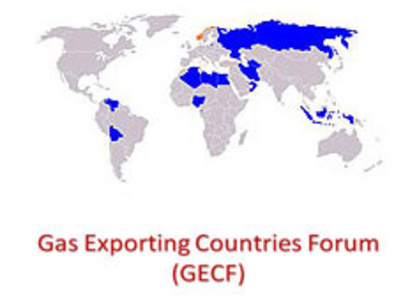GECF; challenges and advantages

By John Roberts, Dalga Khatinoglu
The Gas Exporting Countries’ Forum stands at a turning point: global warming and the need to reduce carbon dioxide emissions should ensure that gas is placed firmly in the spotlight when the world debates climate change in Paris at the end of this month and throughout early December.
So when the leaders of the 13 GECF states meet in Tehran on 23 November, they will be addressing such long-terms questions as the role of gas in contributing to a cleaner, less polluted world as well as more immediate issues like the recent downturn in gas prices and the complications of securing funds for investment in gas production and distribution.

There are both problems and opportunities. Referring to the International Energy Agency’s two-year-old that the world was entering “a golden age of gas” GECF Secretary-General Mohammad Hussein Adeli declared recently that “The Golden Age of Gas will only be 24-carat gold if we argue the case for gas vigorously and we fight to ensure that our fuel’s superiority over many of the alternatives is widely acknowledged.”
Amir Hossein Zamaninia, Iran’s deputy oil minister for international affairs, has said the summit will discuss coordination of production policies, investment and export of gas and the environmental advantages.

Source: EIA
“The timing of the summit could not have been in a more difficult time for the gas market as it is now,” Saadallah Al Fathi, former head of the Energy Studies Department at the OPEC Secretariat in Vienna, said on 15 November. “Gas prices in major markets have fallen sharply and analysts expect further falls,” he added. Al Fathialso noted that one prominent gas analyst, FereidunFesharaki of FGE Energy Consultants, anticipated a further fall to around $4 per MMBTU by 2017 -- compared to last month’s landed prices in Japan of $6.78 and of $6.28 per MMBTU in Europe -- and that a return to levels of around $8 per MMBTU was unlikely before 2020.
But difficult times also offer opportunities. The GECF member states possess various advantages, not least the sheer scale of their resource base and proximity to key markets. Moreover, the rise of liquefied natural gas has enabled many GECF states to ship their gas to distant markets. Algeria, Nigeria, Qatar, Trinidad & Tobago, and the United Arab Emirates all have flourishing LNG exports while Russia is developing LNG facilities in the Arctic and Iran, in the wake of last July’s nuclear agreement with the 5 + 1 powers, is expected to place LNG at the centre of a renewed drive for gas exports.
As for Egypt, its two currently idled LNG facilities at Idku and Damietta look set to gain a new lease of life as a result of the recent discovery of the giant Zohr field in the eastern Mediterranean.
The Secretariat is preparing for the challenges faced by so many of the world’s major gas producers. Secretary General Adeli announced recently: “We plan to present two strategic documents” to the GECF summit; the first being a long-term strategy for the GECF that has already been finalized by its executive committee, and the second a global model of the world gas market. The Global Gas Model is a forecasting and analytical tool aimed at understanding world gas markets and anticipating prospective developments.
“The model, needed to foresee the global gas market in the medium and long-term periods, has been designed and completed over the past two years and marks one of the achievements of the GECF,” Adeli said recently. The new model will cover all aspects of gas market including economic growth, demand, supply, trade, price, storage, transport and contract,” he added.
Such models play a major role in shaping policies and reactions to changing markets. Wood Mackenzie’s Global Gas Model currently anticipates that exports from GECF countries will rise from 488 billion cubic metres (bcm) in 2007 to 1,038 bcm in 2020. Non-GECF exports, which stood at 325 bcm in 2007, are expected to rise to just 430 bcm by 2020. At present, the 12 GECF member states account for more than 40 percent of global gas production, for almost 70 percent of global gas reserves, for 40 percent of cross-border piped gas trade, and for 65 percent of global LNG trade.
It really is a summit meeting. Iranian Oil Minister Bijan Namdar Zanganeh has said that the presidents of Bolivia, Equatorial Guinea, Nigeria, Russia, the United Arab Emirates and Venezuela, as well as the prime minister of Algeria, are taking part. And, of course, President Rouhani of Iran will be hosting the event. The other member states - Egypt, Libya, Trinidad & Tobago, and Qatar – are all sending high-level teams.
But it’s not just the member states that will be taking part in the Tehran deliberations. Turkmenistan, currently developing Galkynysh, the world’s largest onshore gasfield, will be present, with President Gurbanguly Berdimukhammedov attending as a guest. In addition, six states with observer status - Iraq, Kazakhstan, the Netherlands, Norway, Oman, and Peru - will all be represented, with Iraqi President Fouad Masoum leading his country’s delegation and Sultan Qabous heading the Omani team.
---
Follow us on Twitter @AzerNewsAz
Here we are to serve you with news right now. It does not cost much, but worth your attention.
Choose to support open, independent, quality journalism and subscribe on a monthly basis.
By subscribing to our online newspaper, you can have full digital access to all news, analysis, and much more.
You can also follow AzerNEWS on Twitter @AzerNewsAz or Facebook @AzerNewsNewspaper
Thank you!
